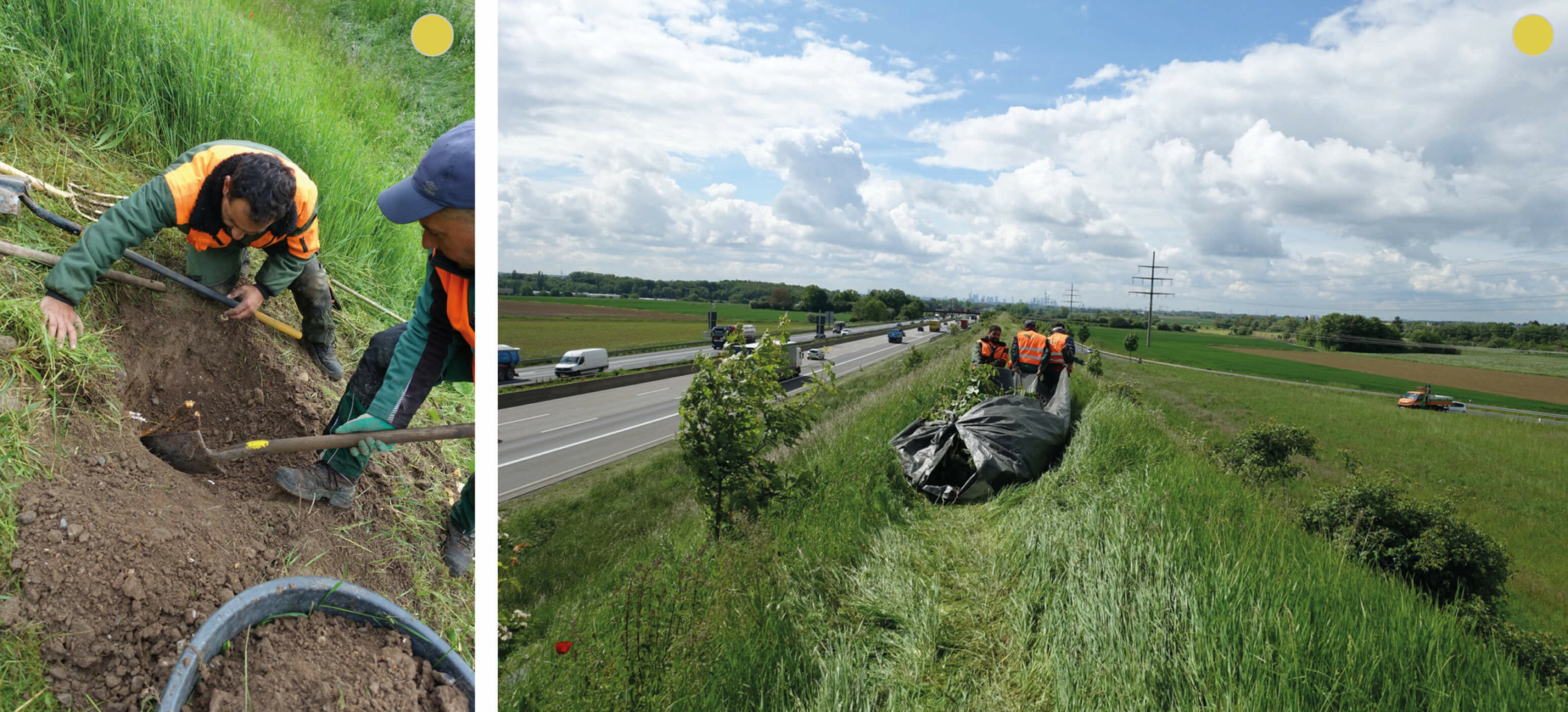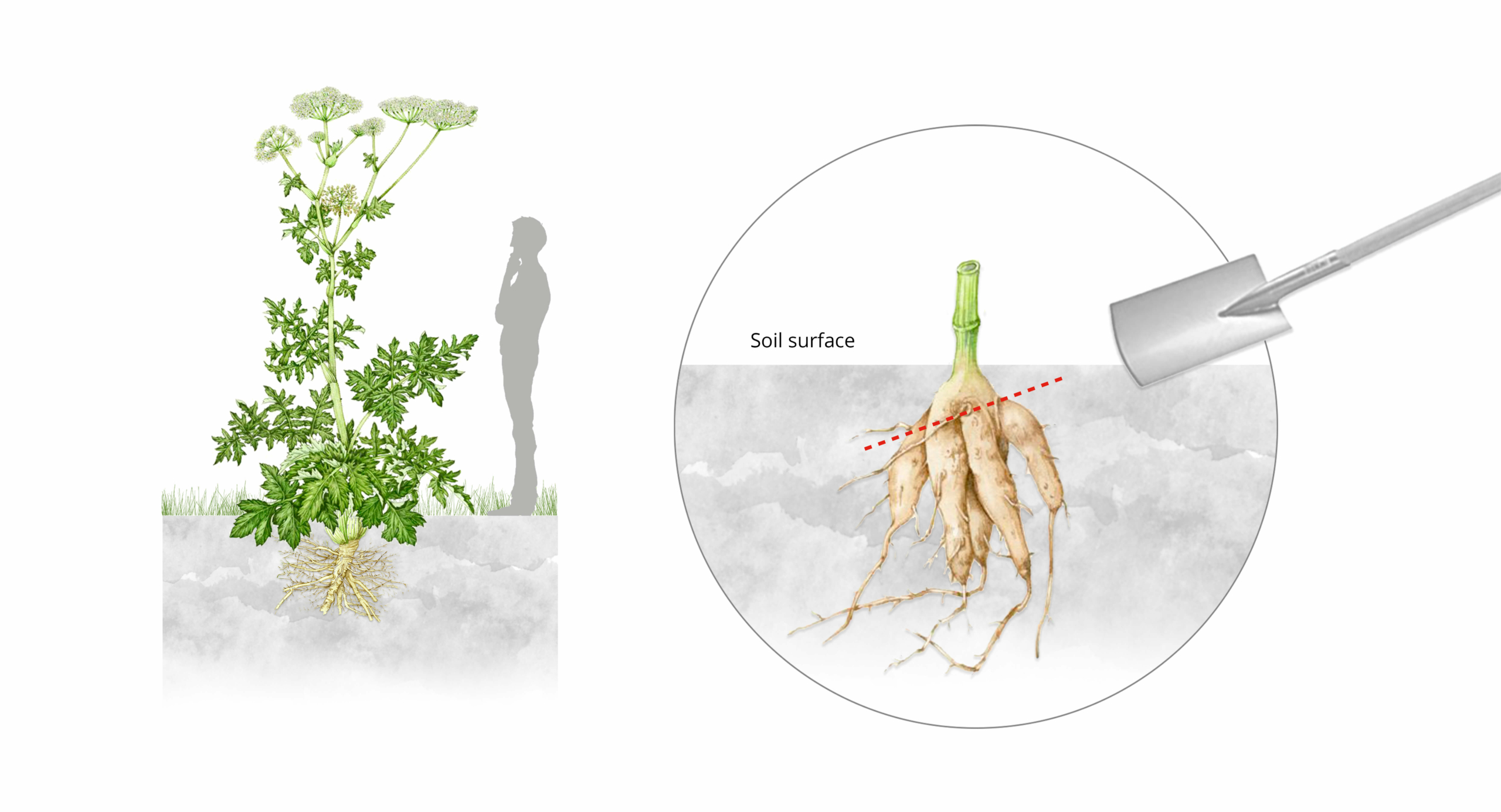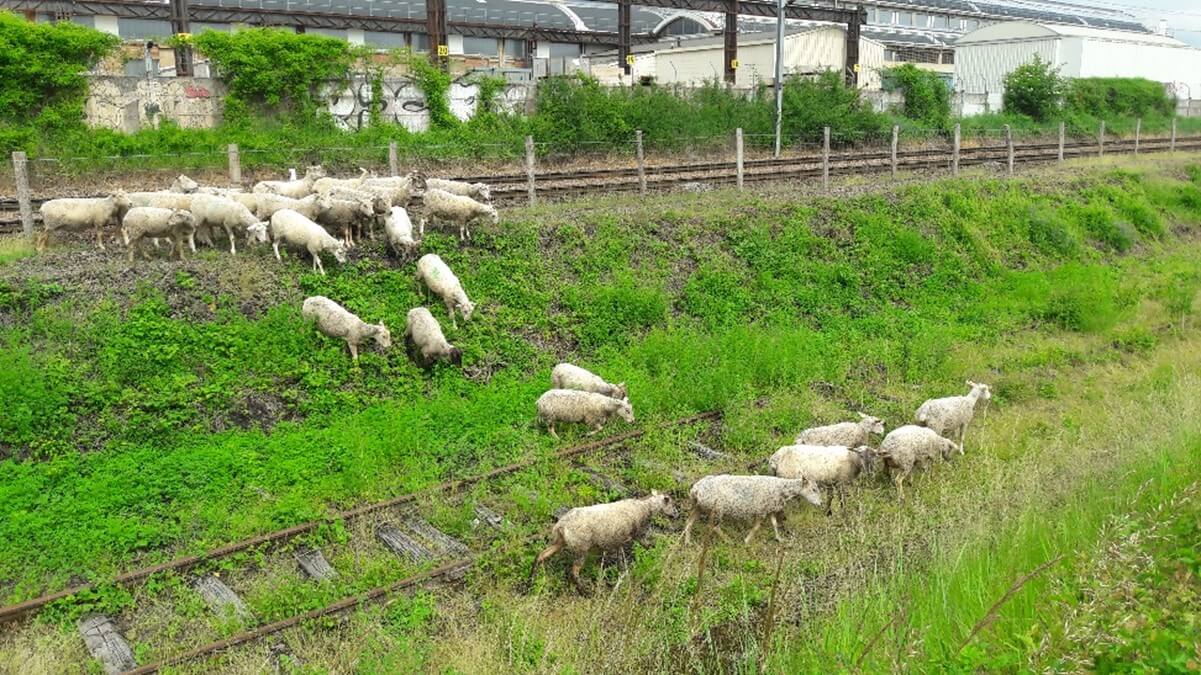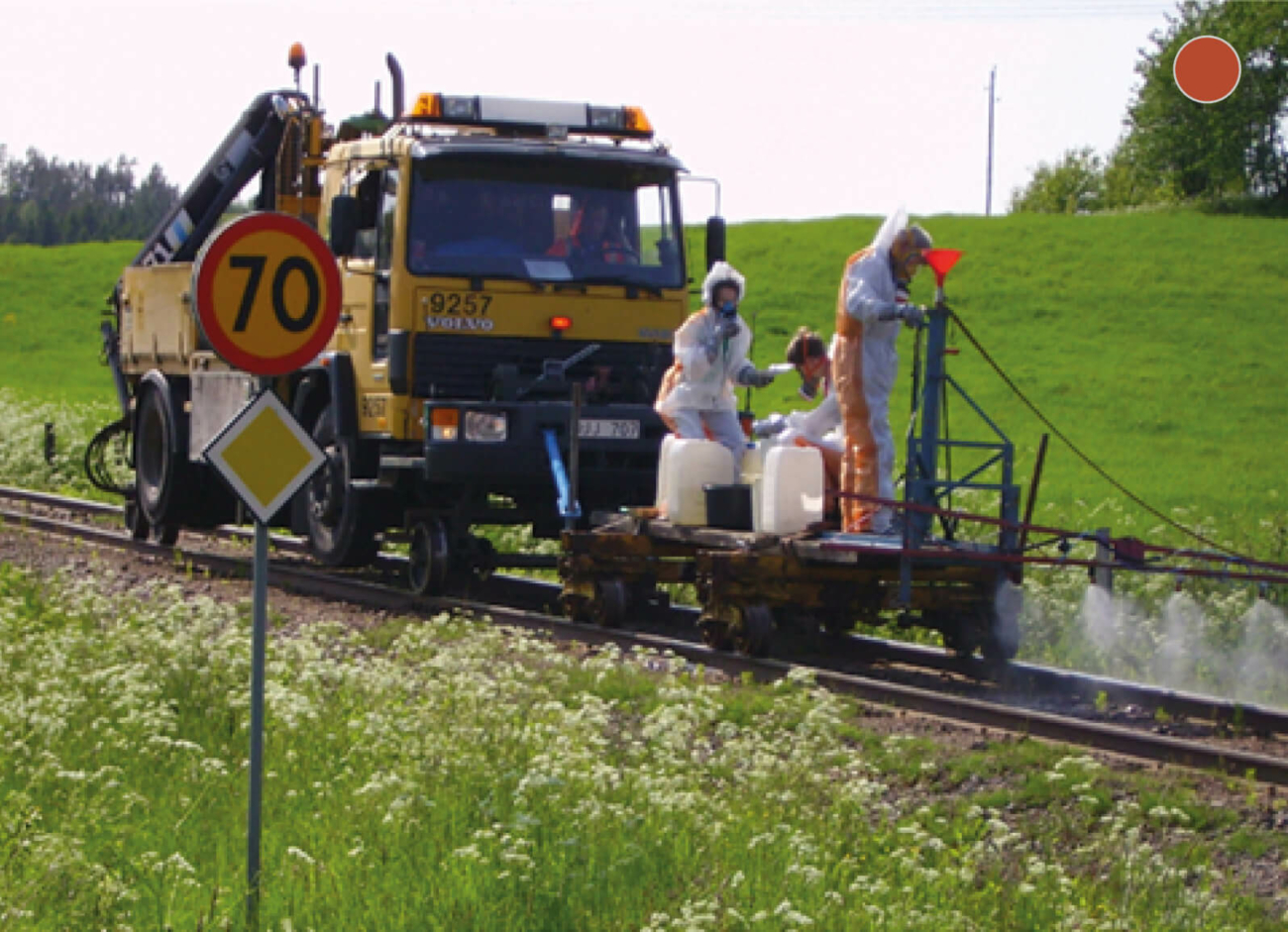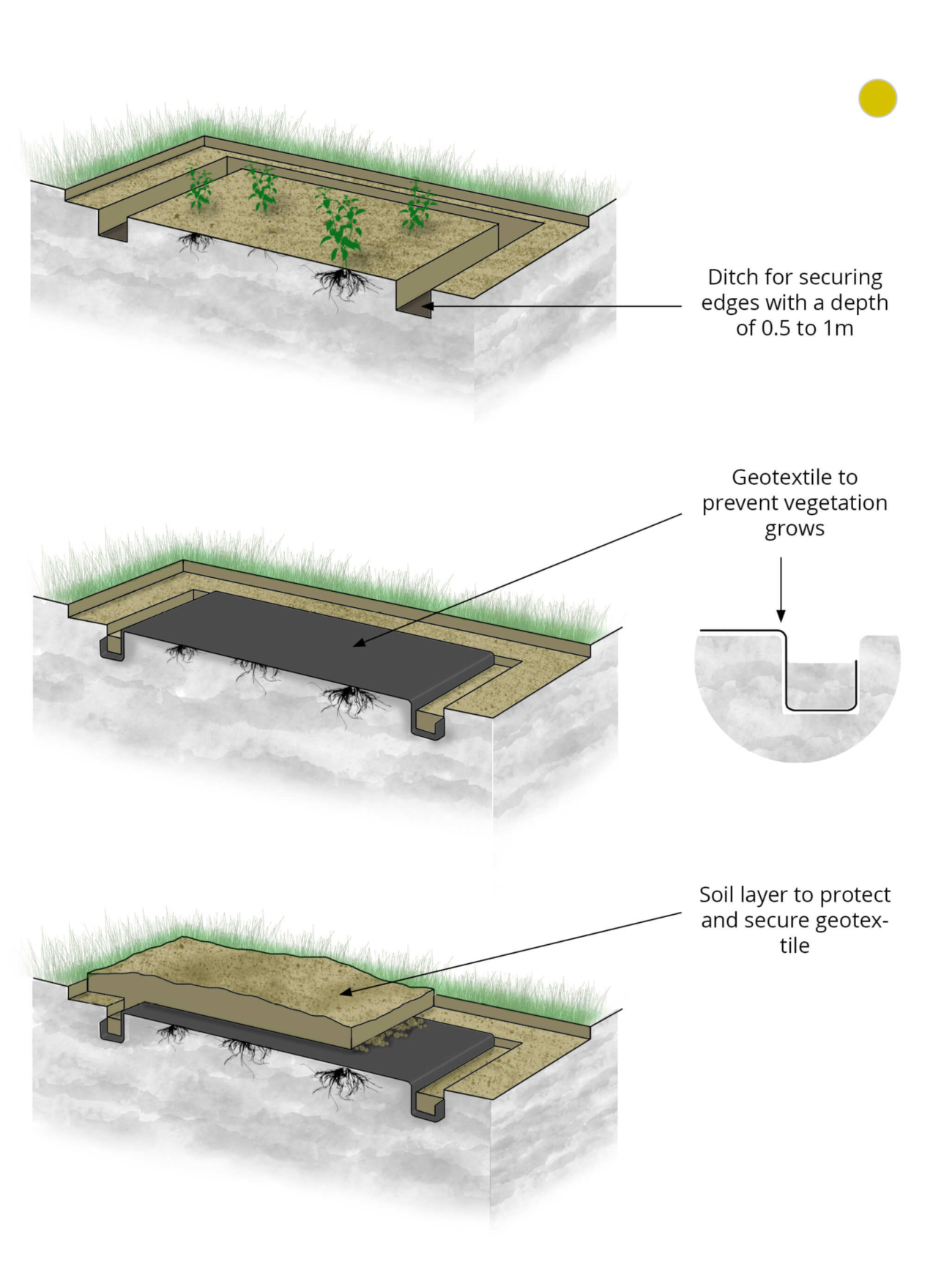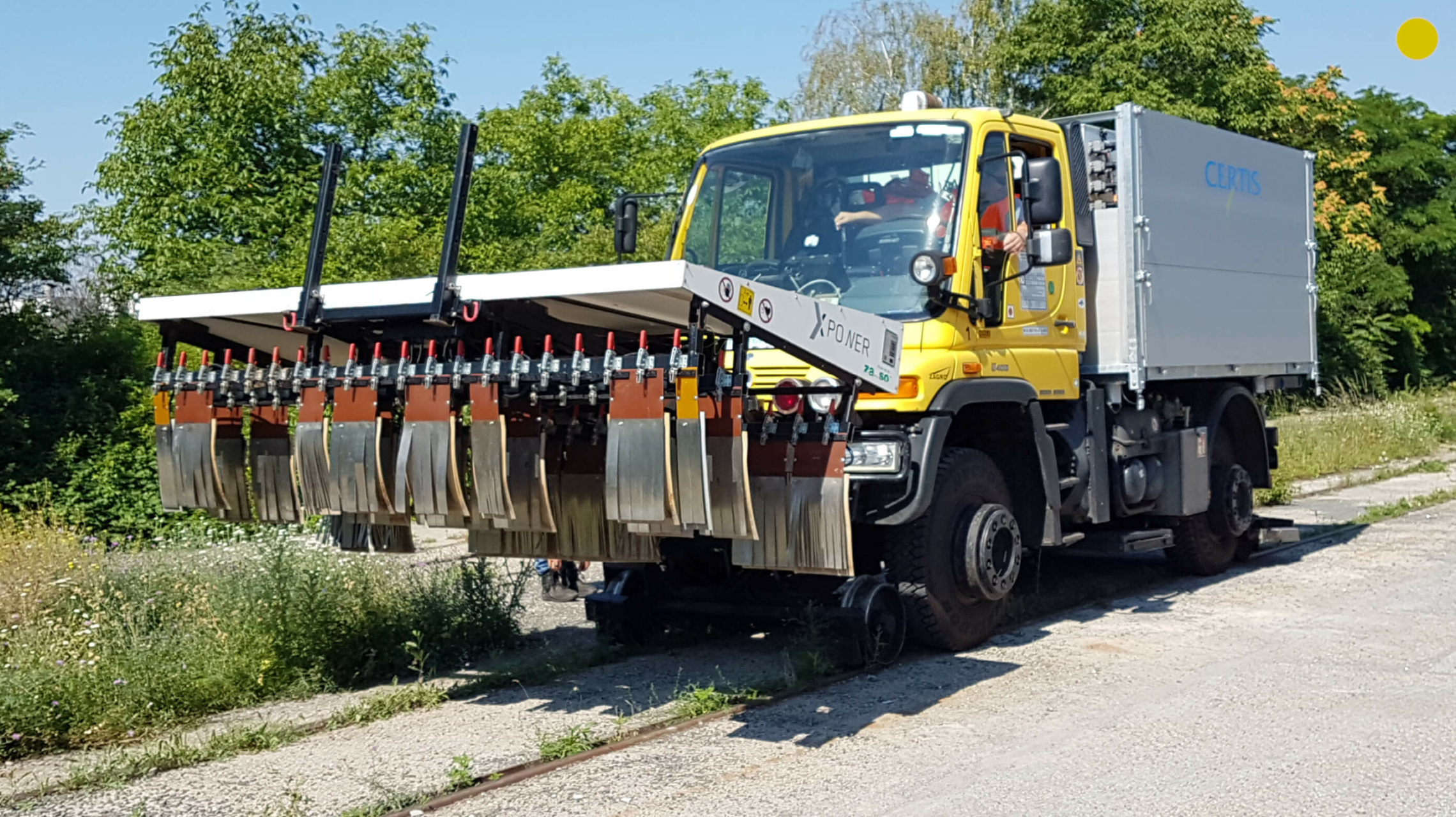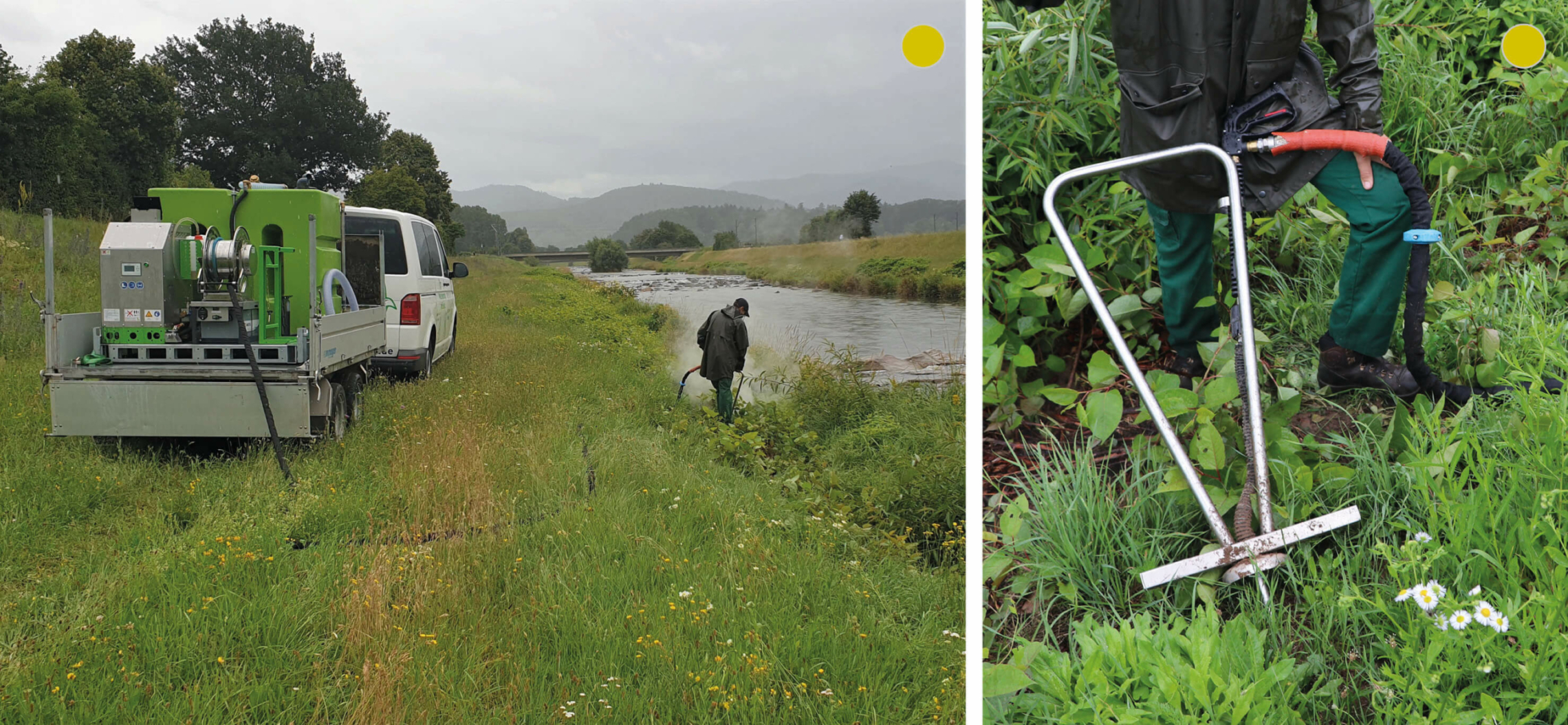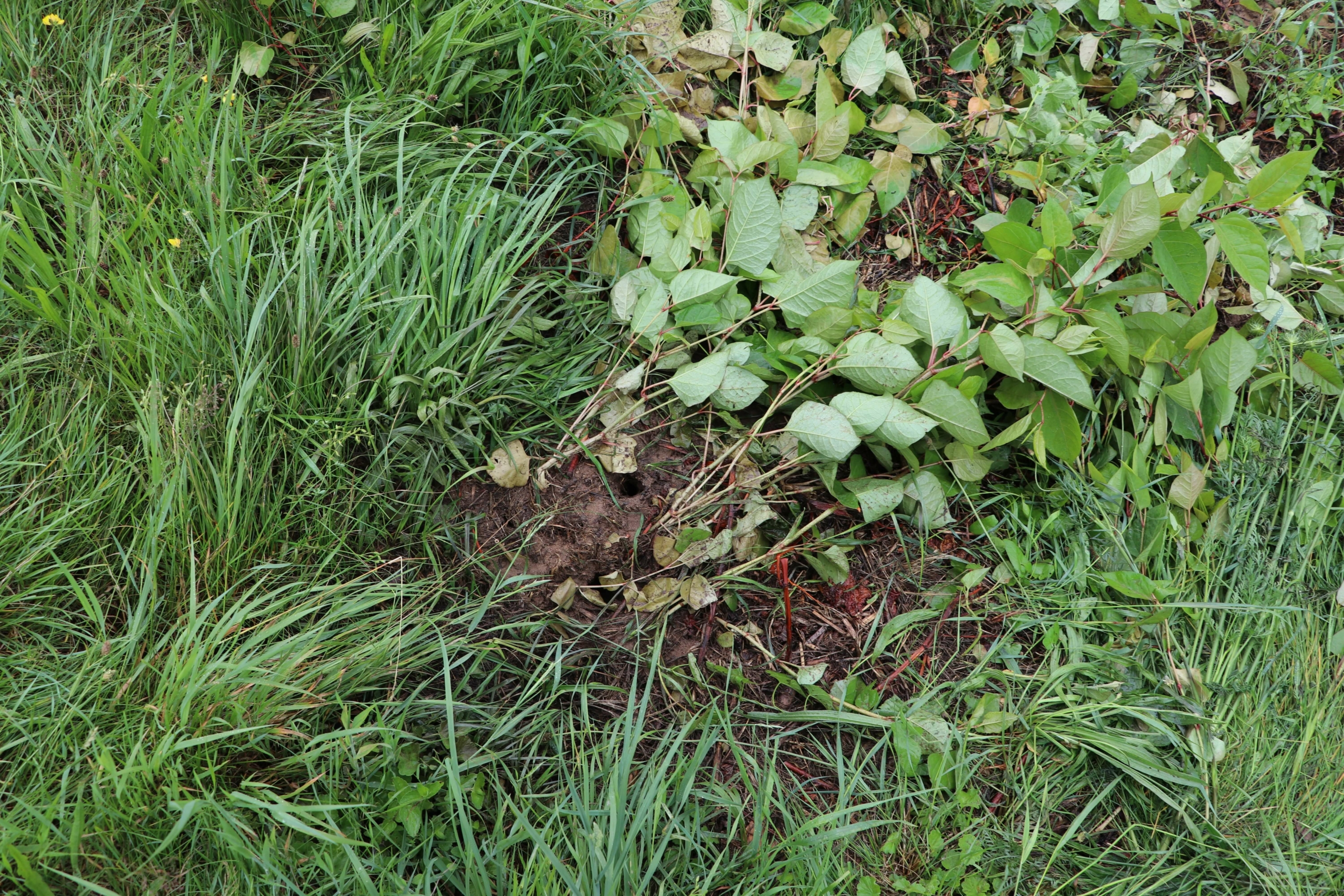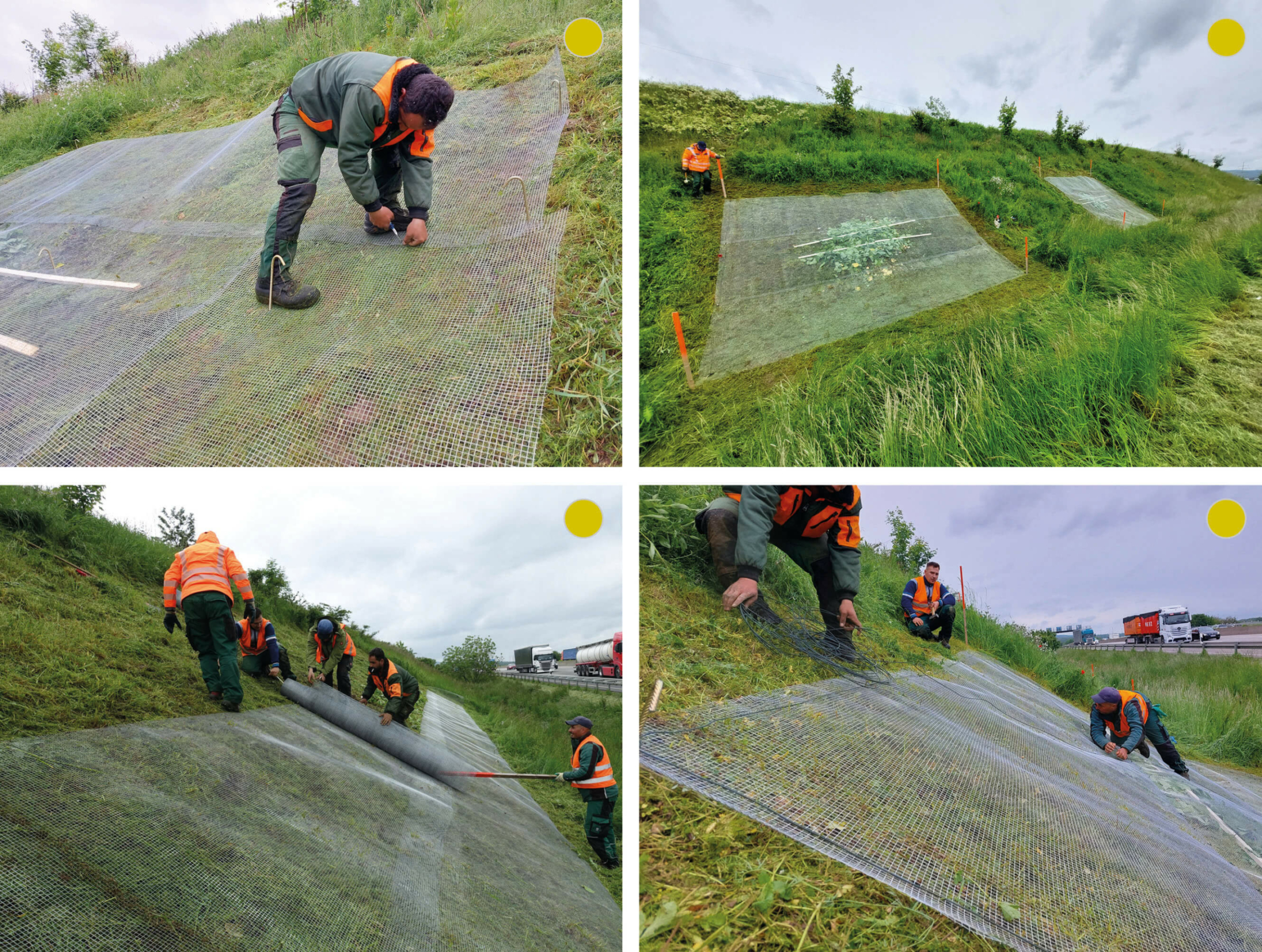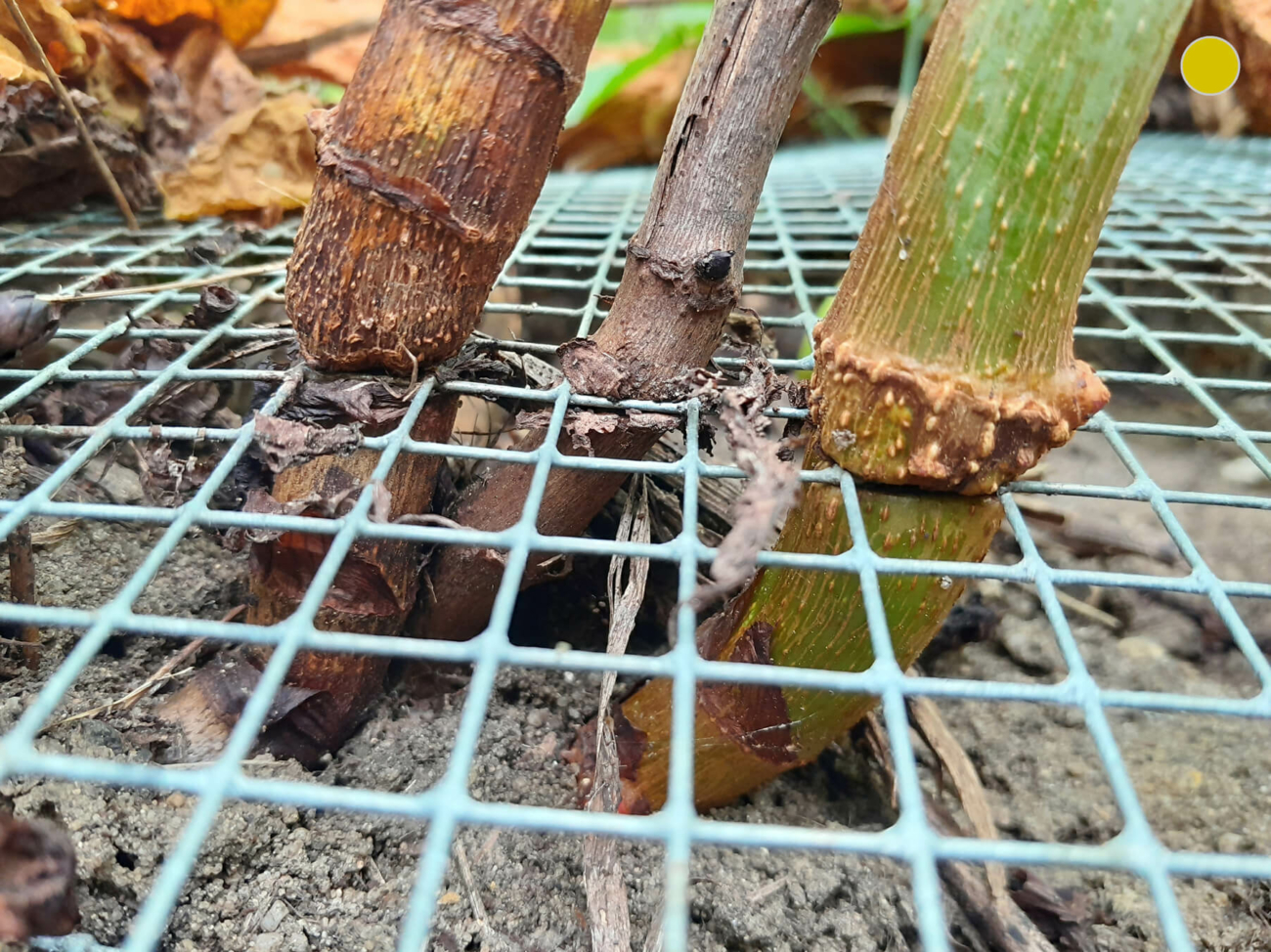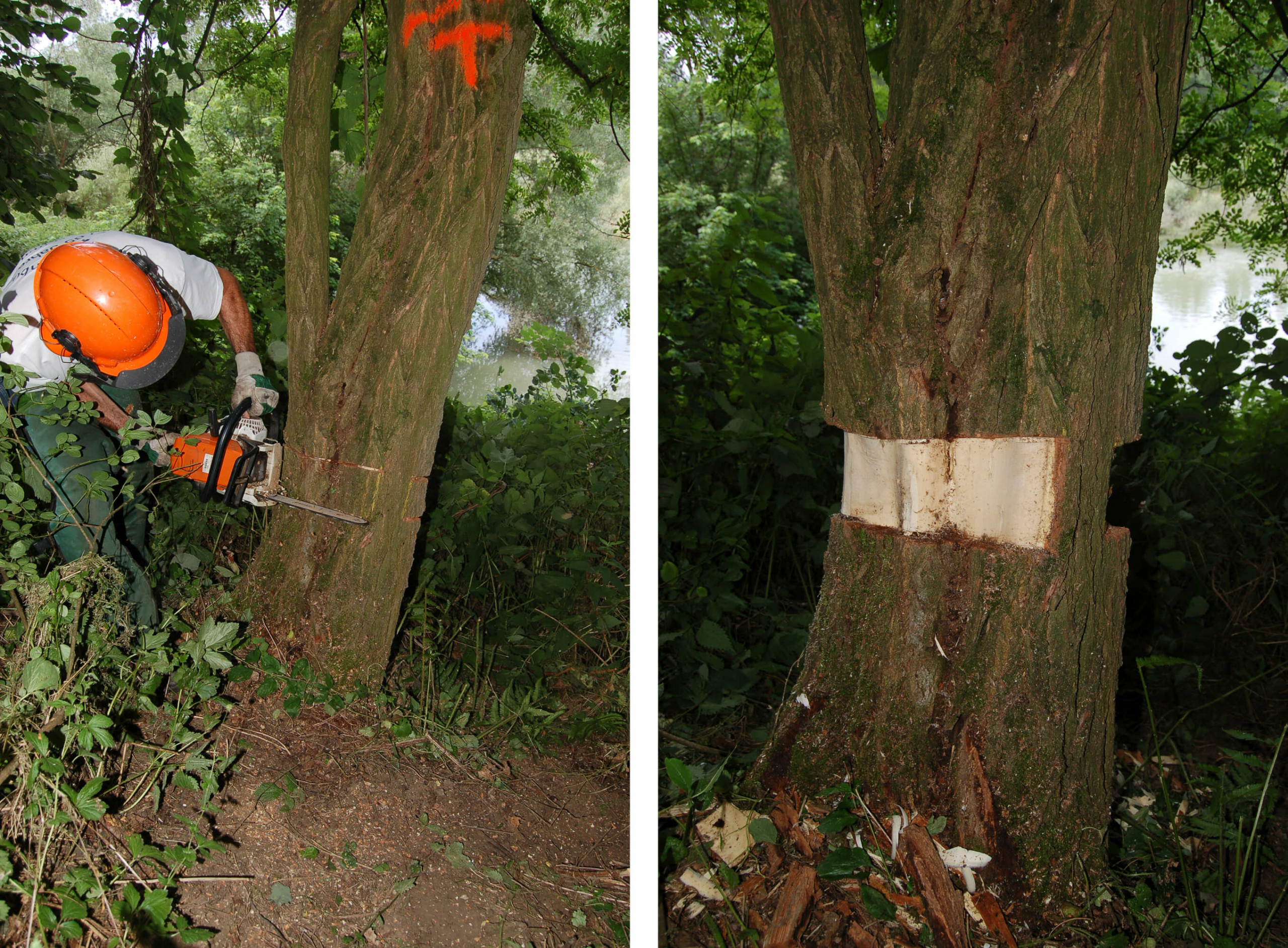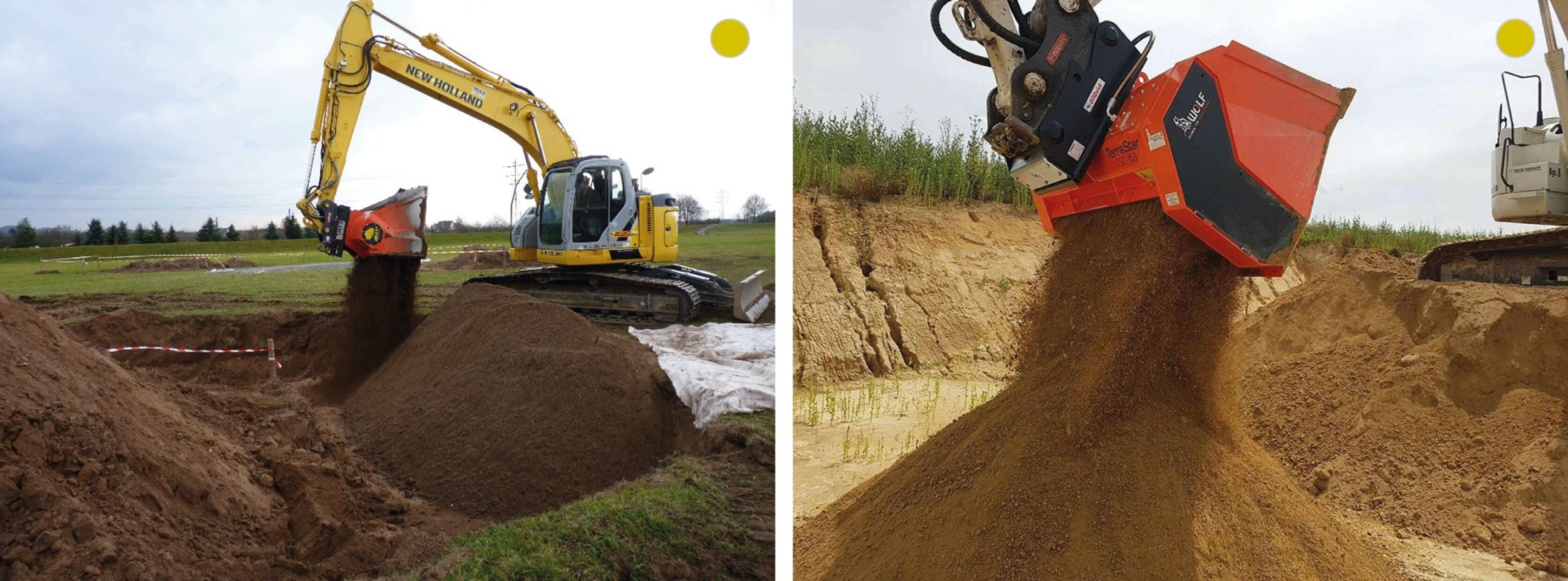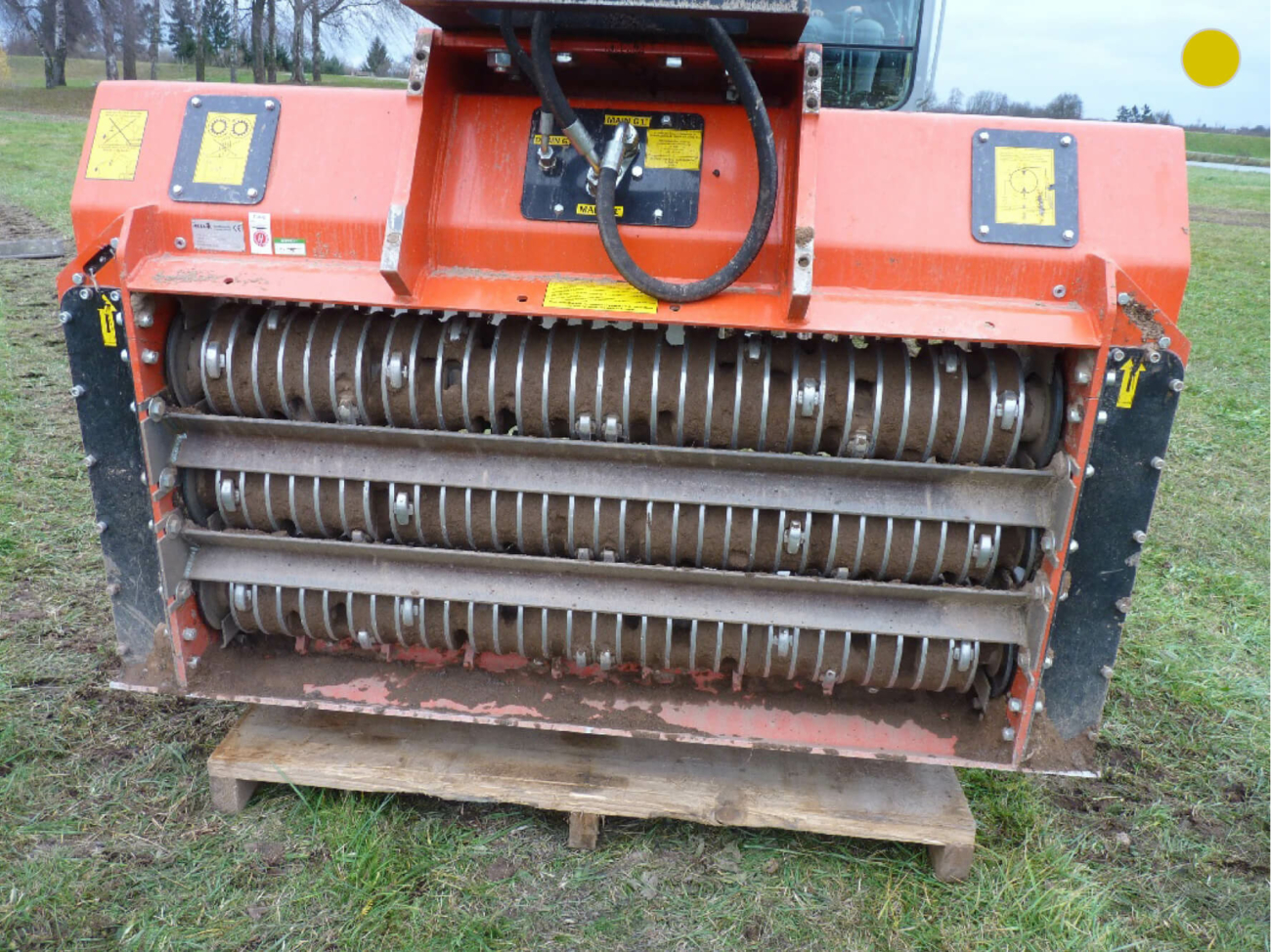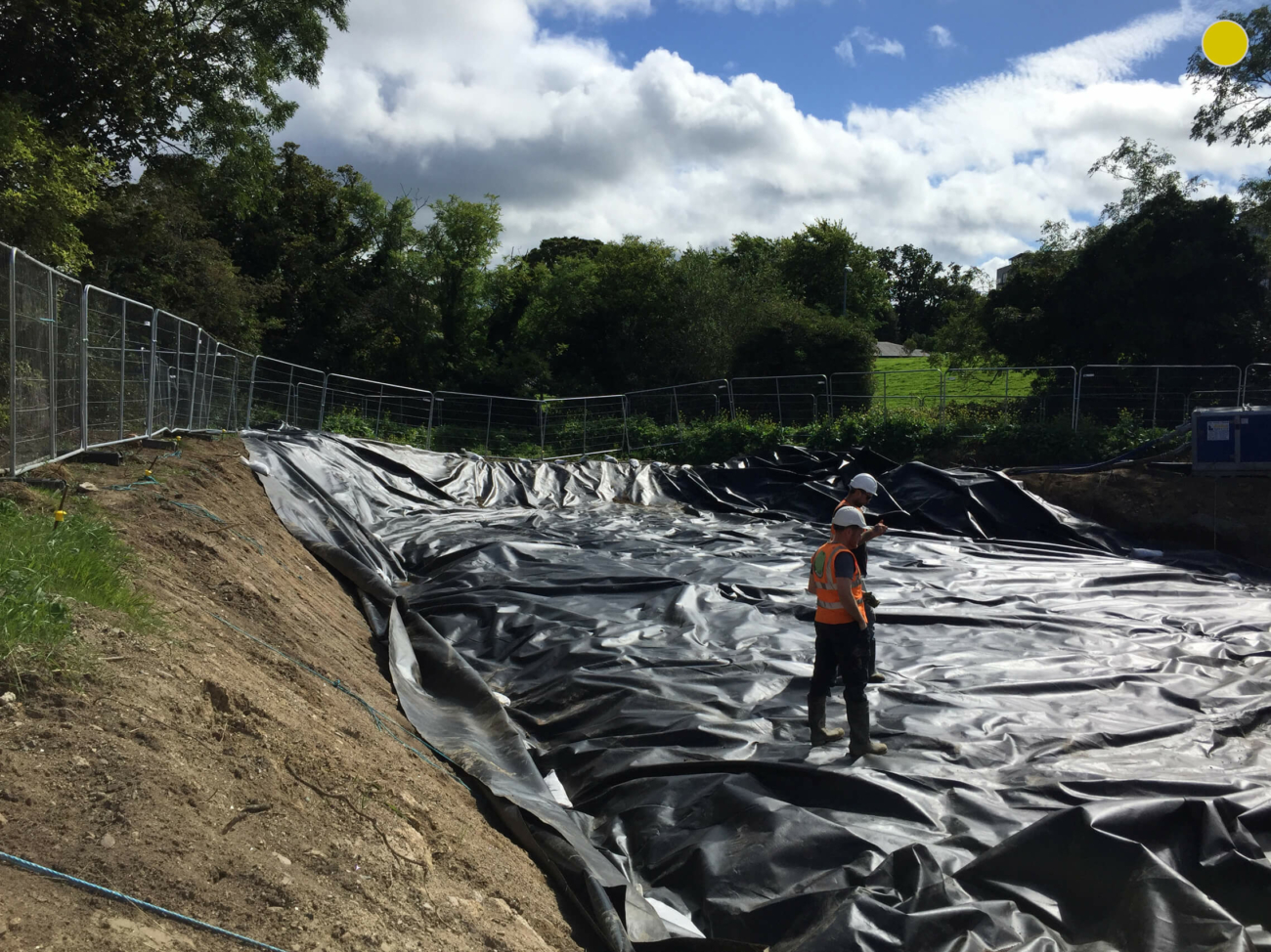Vegetation control
A combination of prevention and different mitigation measures for vegetation control is often most successful. It is difficult to eliminate entire populations, so any control measures need consistency and persistence. Regular follow-up checks on sites are essential even if populations are no longer visible. Often IAS can re-occur from seeds left behind or from undetected rhizomes and roots even years after the above ground biomass has disappeared. For animal IAS, the task is harder as individuals may be hidden or hard to detect like insect eggs or larvae.
General guidelines
- Avoid areas with bare soil and promote closed vegetation cover (see Section Promote vegetation cover).
- Define management schemes for effective and efficient time of maintenance (mowing/mulching shortly before flowering or seed maturity for species of concern) (see Section Timing of verge maintenance).
- Define zones of biodiversity management and separate maintenance of sites with and without the occurrence of species of concern.
- Apply control measurements from upstream to downstream (many plants can spread with the current to downstream locations).
- If necessary, organise the disposal of plant material, and do so whenever possible.
- Use cleaning equipment on machinery, equipment, tools and footwear after treatment of sites where problematic species are present.
- Keep contaminated soil material (including gravel and grit) at appropriate sites (see Section Treatment of soil).
- Use uncontaminated soil -without seeds and other reproductive parts of problematic species- in construction and other movement of soils.
- If IAS has been identified on site or area it is important to follow a standard protocol. The points below give an overview what must be considered.
- Identify target species and identify risks to human health, other species, line-of-sight obstruction and potential damage to infrastructure.
- Record the size of the population. A rough quantitative assessment is often sufficient to categorise population size e.g., no IAS, single plants, small and scattered populations, numerous populations, widespread or dominant. Estimation of animal populations may be much more difficult.
- Check legal requirements for the site, if any.
- Define biosecurity measures for the site.
- Define specific measures against the target species.
- Define cleaning requirements for the working site.
- Provide storage on site for equipment and waste.
- Define time and frequency of the measures to be applied.
- Estimate a budget for the maintenance, including elements such as working hours and equipment if applicable, and for cost of preventive measures linked to early interventions, depending on the contamination.
- Monitor and keep a record of differences observed between site visits.
Different measures are available to control IAS and other problematic plants which aim to achieve different goals. Some are suitable merely to control populations and prevent further spread but don’t result in eradication. Others may eventually result in eradication if applied effectively and consistently. The level of maturity, i.e., how well tested the measures are and if their effectiveness is verified, varies greatly between the different measures and it is very hard to find scientific evidence for the effectiveness of different control measures. Some measures appear to control IAS vegetation successfully but often fail to completely remove or eradicate IAS and other problematic species. The success of each measure depends on how accurate it is, the timing and frequency of application. For each measure listed here (Table 5.9) there is a preliminary qualitative assessment of its effectiveness. In the interests of developing best practice, anyone responsible for testing measures to control and eradicate IAS and other problematic species is encouraged to make their results available for consultation.
The cost of measures must be included in assessing effectiveness and has to be factored in when planning strategies to deal with IAS. Costs begin with an estimation that increase with the IAS population size, its distribution area and the length of time it has been established. The additional costs of ensuring field crew and traffic safety must also be included.
Table 5.9 – Overview of methods to control IAS vegetation with an indication of effectiveness. Estimated cost based on information from methods applied in Germany (BASt and Baader Konzept 2019). ‘-‘: no data available.
| Method | Aim | Effort | Cost | Maturity level | Cost (€/m2) |
| Regular cutting | Control | High | Low | High | 2,5 |
| Manual removal – pulling | Control / Eradication | High | Low | High | 1,2 |
| Manual removal – digging | Control / Eradication | High | Low – High | High | depends on size and age of populations |
| Grazing | Control | Low | Low | High | 0,25 plus fencing and maintenance |
| Herbicide use | Control / Eradication | Medium | Low | High | 0,5-6 |
| Alternative active substances / bio-herbicides | Control / Eradication | Medium | High | Low | – |
| Covering | Control / Eradication | High | High | Medium | 30 |
| Burning of aboveground IAS material | Control | Medium | Medium | Low | – |
| High current / Electro-weeding | Control / Eradication | High | High | Low | 100 |
| Hot water / foam | Control / Eradication | High | Medium | Low | 15 |
| Liquid nitrogen | Control / Eradication | High | – | Low | – |
| Wired mesh | Control / Eradication | Medium | Medium | Low | 20 |
| Brine | Control / Eradication | Medium | – | Low | 2 |
| Over / competition planting | Control / Eradication | Medium | Medium | Medium | 30 |
| Curling of trees | Control / Eradication | High | Low | Medium | – |
Timing of verge maintenance
It is essential to plan for a certain degree of flexibility in the timing of green area maintenance to adapt it to flowering periods that could vary every year and from site to site. This adaptation is crucial to prevent IAS reproducing. Hence maintenance schedules should have some leeway. Extra time should also be included when creating management plans, depending on the extent of the problem, for maintenance staff to carry out repetition of measures during follow-up checks.
Mowing / mulching should take place before any species of concern set seed or reach seed maturity, allowing for the simplified disposal of green waste.
The best mitigation results can usually be seen by mowing in mid-summer (June/July). Maintenance timing can vary depending on the biology of the plants. The table below is an overview of plants of concern for which control is recommended (Table 5.10 in Supplementary information).
In the case of larger and more diverse occurrences of problematic species, it is recommended that a mowing concept is drafted with specialist input, which should then be adjusted annually.
Pruning is most effective during blossoming as biomass/energy depletion is greatest, however, for some species, the immediate removal of flowers is necessary (e.g., ragwort species, Senecio sp.).
Temporal separation of maintenance of affected locations
- Locations with high occurrence of problematic species have an increased risk of further spread and should be prioritised and treated with specific standard of care.
- Locations where a few IAS individuals are apparent should be mowed separately after all other areas.
- Sites IAS free should be preserved by dealing with them separately to those where problematic species are present. Best practice should be applied by using separate tools for maintenance or guaranteeing appropriate cleaning equipment procedures.
- Special care should be taken when dealing with plants that use asexual propagation (e.g., Japanese knotweed Reynoutria japonica) to avoid any spread.
- Special attention should be given to areas where problematic species could be a threat for traffic safety.
- Environmental restrictions, such as the bird breeding season, must be taken into account before undertaking measures to protect vulnerable species.
IAS control along verges and riverbanks
Verges along roads and railway generally need to be differentiated into different sections. Areas directly adjacent to the traffic lane (usually the first 1-2 m) need to be maintained frequently for safety reasons whereas the areas behind this do not have to be maintained every year (see Section 5.7.1 – Verges and other green areas).
The railway operational corridor (ballast bed and slab track, transition area; see Section 5.10.1 – Measures to reduce risks caused by railway electrification system) also needs different maintenance management to other areas which ensures operational and occupational safety, such as verges and embankments and the sealed and unsealed area associated with road and rail corridors. The accessibility of these areas may vary and may provide different habitats for flora and fauna. If IAS or other problematic species occur in any of these zones, control measures need to be activated even if those sections are not regularly maintained.
Not all plants on the list of IAS of Union concern (Regulation (EU) 2022/1203) cause problems to transport infrastructure operators. However, there are several plants that cause similar problems to IAS but which are not on the EU list. Table 5.11 and 5.12 (in Supplementary information) provide information about plant species of concern for transport infrastructure management highlighting in first place those that require to be strictly controlled because are IAS of Union concern.
Banks along rivers can be easily eroded by currents, waves and flooding. This is of particular concern when vegetation establishes quickly and may die off completely after a period to leave bare soil. In particular the following plants should be monitored and controlled and initial populations eradicated (Table 5.11 in Supplementary information).
While perhaps requiring different equipment, good practice would be to treat riverbanks similarly to verges (see Section 5.7.1 – Verges and other green areas). Riverbanks often have difficult access due to e.g., rock and stone filling. Measures should always be applied from upstream to downstream as reproductive parts of many plants can survive transport in water and thus spread further downstream.
Vegetation along waterways has a high ecological value and is important for waterways management as it provides shading, embankments stabilisation, a buffer area and can assist in self-cleaning of the water. Grass embankments need cutting and are often intensively maintained close to settlements. It is good practice to remove cuttings to prevent any clogging of water basins that are meant as flood prevention and if possible, material should be used for hay. Because there is no wildlife-vehicle collision risk along waterways, grazing can be recommended as an efficient and cost-effective method of vegetation management.
Woody embankments need attention if trees are ill or dead and may fall. Clear cutting of large areas should be avoided to ensure shading (<15 m). A mosaic pruning strategy maintains shady areas that are less likely to be occupied by IAS. Occasional rejuvenation can keep embankments safe and promotes biodiversity. The following trees should not be planted along waterways: Eastern cottonwood (Populus deltoides), Black locust (Robinia pseudoacacia), Tree of heaven (Ailanthus altissima) and coniferous trees.
It is recommended that shrubs are kept at the high tide line due to their importance for avoiding deer and other animals to fall in.
Maintenance is not recommended during bird breeding seasons and should take place during winter months (August-March). It is recommended to prune in 50 m sections with an annual turnover in order to allow animals flee and hide during the maintenance.
Regular cutting
Fast growing plants are recommended to be cut back every 3-4 weeks during the growing season (from May to October) and after that less frequently. It is highly recommended that mowing and cutting starts in early midsummer rather than late summer/autumn. The measure has to be repeated for years and it is recommended that rhizome plants are dug out (see Section Manual removing – digging). Note that cutting does not result in eradication of IAS populations and is only a means of controlling and preventing further spread, therefore the cost of regular mowing 5-8 times a year should be carefully balanced with more costly measures. Normally a ‘once off’ costly measure involves removal of an IAS by digging it out and installation of growing barriers, which might turn out to be more cost efficient than years and years of regular mowing.
This method is typically used for IAS, and other species of concern, such as Common ragweed (Ambrosia artemisiifolia), Giant hogweed (Heracleum mantegazzianum), Common ragwort (Senecio jacobeae), Giant Canadian goldenrod (Solida canadensis / gigantea), Black locust and Russian olive (Elaeagnus angustifolia). Mowing twice per season also controls Persian hogweed (Heracleum persicum) and Sosnowsky’s hogweed (Heracleum sosnowskyi).
Advantages of regular cutting:
- Can be used to quickly restore safety e.g., sight lines.
- Can utilise a tractor/unimoc attachment for large areas.
- Can potentially be automated by autonomous robots (currently being tested on railways by the SBB and SNCF Réseau).
Drawbacks of regular cutting:
- Not suitable for complete and sustainable removal.
- Labour intensive, costly and time consuming.
- Risk of further dispersal by machinery.
- No removal of plant roots.
- Can promote flowering and seed production.
- For some species, green waste must be removed and disposed at certain times.
Manual removal – pulling
The manual removal of plants is a very time consuming and labour-intensive method. It is recommended to pull out plants as soon as possible and repeat this measure 3-6 times a year depending on growth. While it seems unreasonable, this manual removal, either by pulling or digging, is highly recommended during the early stages of establishment. If the infestation is small, manual removal is the most effective measure for long-term success.
Aquatic plants can be pulled out manually but is generally not recommended. It carries a significant risk of exacerbating the problem and high biosecurity standards are important regarding clothing and equipment.
This method shows great potential for Japanese knotweed.
Advantages of pulling:
- Very effective in dealing with small populations.
- Repeated removal over a few years can completely eradicate IAS.
- No chemicals, no pollution.
- No restrictions required at the area.
Drawbacks of pulling:
- Laborious and time consuming.
- Not suitable for large populations.
Manual removal – digging
Digging out either manually or with a digger is recommended in particular for plants that produce rhizomes (Figure 5.8.7). Soil removal should be generous and removal depth depends on the age of a population because the longer it has been established, usually the deeper are the rhizomes. Also, if plants have been introduced superficially (e.g., with mowing equipment), the populations usually do not root as deep as populations that have been introduced with soils.
Soil removed must not be used somewhere else because plant and soil material must be disposed of appropriately. If done thoroughly this measure has a high success rate.
There are commercially available hand-tools (e.g., Fiskars® weed puller) that can successfully remove whole plants including the roots. Such tools are especially suitable to remove ragwort species. These measures are best applied after rain when the soil is moist to avoid the risk of roots breaking off. For many problematic species, root parts that are left behind will generate new plants.
Giant hogweed is best controlled by digging out the fleshy tap-root or by cutting the tap-root off approximately 15 cm below ground. Cutting hogweeds (Heracleum sp.) roots with appropriate tools could also help to prevent re-growth (Figure 5.8.8).
Advantages of digging out:
- Very effective for smaller populations.
- Eradication possible after one treatment (however, regular check-ups need to be undertaken for seedlings).
- No chemicals, no pollution.
Drawbacks of digging out:
- Labour intensive and time consuming (especially by hand).
- Very intrusive of the soil.
- Restoration required to ground cover (soil and sowing).
- Areas might not be suitable for heavy machinery.
- Disposal of large amounts of waste.
Grazing
A very effective method of IAS control is livestock grazing using cattle, sheep and goats along waterways and – if appropriate – road and railway verges (Figure 5.8.9). Areas should be grazed 3-4 times a year. Some of the most problematic species can be kept in check by regular grazing which can for example weaken populations of otherwise tall growing Japanese knotweed. In theory this method could be applied in all transport sectors but is rarely considered along roads and railways due to safety concerns.
Advantages of grazing:
- Uses the power of animals and can assist in supporting local shepherds.
- Reduces the IAS population size.
- Makes less likely the further dispersal of IAS.
- Restores vegetation cover and has positive effect on biodiversity.
- Can be used along waterways.
- No special disposal of plant material required.
- Viewed positively by the public.
Drawbacks of grazing:
- Is not as safe or safe at all along roads or railways.
- Doesn’t offer complete IAS eradication.
- Requires the input of skilled herders and there is a limited availability of herds.
- Limited suitability in periurban areas due to the possibility of herds causing damage to gardens and crops.
Herbicide use
The use of herbicides along road and railway verges is not permitted in many countries (Figure 5.8.10). Because some plants can grow into track beds and cause damage, there are some exemptions along railways. The use of herbicides in the immediate proximity of a body of water is not permitted and herbicides must not be used on waterways.
The use of all pesticides and risks associated with their application should be halved by 2030 as a legally binding goal on all EU members (see continuation regulation draft of European Parliament (2009, Directive 2009/128/EC)). All transport sectors should be encouraged to work towards the reduction of pesticides.
Herbicides are not recommended and are the least favourable option because they have severe side effects, are prone to travel far by air and take a long time to degrade. It is also noteworthy that a growing number of herbicides have been withdrawn from the market place, and many leave open areas of soil which can create new opportunities for IAS so alternative methods and substances should be preferred over chemical products. Herbicide use should be minimised and be considered only in exceptional cases where all other options have been exhausted. In the event of herbicide deployment, it is important to comply with national guidelines and special permits. The timing is very important in minimising side effects and increasing success of IAS control. Spraying is not recommended during the period of flowering because foraging insects and pollinators could be severely harmed.
Advantages of herbicide use:
- Eradicates IAS.
- Requires only 1-2 treatments per year, over 2-3 years.
Drawbacks of herbicide use:
- Affects non-target organisms.
- Needs permissions and trained personnel.
- Has pollution and drift effects.
- Can lead to genetic resistance in plants.
Alternative active substances/bio-herbicides
Currently, the potential of organic acids to control IAS is being tested. One prominent example is the application of pelargonic acid to minimise negative side effects on flora and fauna but which has similar results to a chemical herbicide.
Advantages of alternative/bio-herbicides:
- Local control of IAS.
- Existing equipment normally used with conventional herbicides can be utilised.
- Reduced risk for maintenance staff in comparison with conventional herbicides.
- Biodegradable.
- Potential for use in all areas.
Drawbacks of alternative/bio-herbicides:
- High cost and large amounts required.
- Possible leaching of heavy metals.
- Trained personnel are required.
- Can lead to genetic resistance in plants.
- Most effective used in combination with conventional herbicides.
Covering
The process of covering is begun with the close cutting down of IAS plants and then the removal of up to 25-50 cm of the topsoil, depending on the depth of roots and rhizomes and length of time the IAS has been present (Figure 5.8.11). The longer a population is established the deeper go roots and rhizomes Great care must be exercised in disposing of cuttings and the resulting topsoil. Laying of suitable cover materials are thick mats of fibres then takes place. Great care should be taken when integrating mats.
- Mark the area plus a 2-3 m buffer area to the sides.
- Lay mats at least 2 m beyond the area of the last recorded above-ground IAS shoot.
- Gluing mats of fibres with double sided tape together in three layers is recommended.
- Dig deep to secure the edges of mats (0,5-1 m).
- Check for holes in the mats ensuring that these are completely sealed.
- Cover the whole area to a sufficient depth with IAS-free soil which avoids damage and UV-degradation of the mats and prevents their lifting due to shoots that may initially regrow underneath.
- Re-sow to avoid open areas.
Advantages of covering:
- Complete eradication of IAS.
- Only one application required, with optional restoration after a decade or two.
- Suitable for building sites.
- Suitable for small and large populations.
Drawbacks of covering:
- Very labour and time intensive with a high cost.
- Very intrusive.
- Not suitable in areas which cannot provide the required easy access.
- Introduces plastic into the environment.
Burning of above ground IAS material
Plants can be burnt on site using handheld devices or with tractor attachments. Gas flames generate the required heat and this measure is recommended for application up to three times a year. Burning is not generally considered good practice and usually needs special permission.
Advantages of burning:
- Quick control of IAS.
Drawbacks of burning:
- Temporary measure to eradicate only plant material above ground which does not remove roots or rhizomes.
- Fire hazard and safety issues are created.
- Permission necessary.
- Easy access required if using tractor attachments.
High current treatment/electro-weeding
This method relies on the electrical conductivity of the ground so is not suitable in very dry conditions. A tractor with attachment can be used (e.g., Elektroherb™ by Zasso) or an injection lance (e.g., Rootwave™) for smaller areas or those not easily accessed (Figure 5.8.12 and 5.8.13). Whole plants, including rhizomes, are electrocuted with a high current and die. Contact with leaves is sufficient to distribute the current and a direct wilting of plants can be observed. Plant material can be left on site. Effects on ground and soil fauna including microbes are not yet known. This method is unsuitable if below ground wires and pipes are present.
Possible target species for this method include common ragweed, knotweeds and hogweed species.
Advantages of high current treatment:
- Kills whole aerial part of the plant which cannot then reproduce.
- Has a long lasting effect.
- Plant material can be composted or left on site.
- Involves no chemicals.
- Can be used in water protection zones.
Drawbacks of high current treatment:
- Requires repeated applications.
- Success depends on ground conditions favouring conductivity.
- Occasional fire hazard and safety issues arise.
- Trained personnel are required.
- Needs easy access if a tractor attachment is used.
- Direct contact with railways or signalling systems must be avoided.
Hot water/foam treatment
Pants are sprayed with hot water (99°C) and additional hot water is injected with lancets into the ground, killing the plants and roots/rhizomes (Figure 5.8.14; Figure 5.8.15 and Figure 5.8.16). Dead plant material can be left on site. Caution must be used by maintenance staff and protective equipment is highly recommended to prevent burns. Repeating this treatment 4-5 times a year over three years is recommended.
Specialist trains are available that can treat long strips of rail bed with hot steam (Figure 5.8.17 and Figure 5.8.18). Alternatively, biodegradable hot foam can be used and tests are currently being conducted by RFI (Italy). The foam results in a prolonging of the burning effect compared to hot water.
While results of tests carried out so far are promising, any consequences for biodiversity and side effects, such as leaching, require further investigation.
Possible targets for hot water treatment include common ragweed and knotweeds species.
Advantages of hot water treatment:
- Kills whole aerial part of the plant which cannot then reproduce.
- Plant material can be left on site or composted.
- Degradation of treated plant material is faster than usual.
- No chemicals or further pollution.
- Plants cannot develop genetic resistance.
- Water can easily be transported for treating railways and can potentially be heated with renewable energies.
Drawbacks of hot water treatment:
- Repeated application is necessary.
- Is labour intensive.
- Needs trained personal.
- Needs easy access if a tractor attachment is to be used.
- Poses a danger to small animals that can be injured or killed during application.
- Large amounts of water applied to the ground may create erosion or damage the infrastructure.
Liquid nitrogen
Plants can be killed off using liquid nitrogen and this method is currently being investigated along railways. There are reservations surrounding this method which makes it hard to recommend. It is expensive in comparison with other measures and has a very negative energy budget. It is listed here for completeness.
Advantages of liquid nitrogen treatment:
- Kills whole aerial part of the plant immediately which can no longer reproduce.
- Plant material can be left on site or composted.
- Plants cannot develop genetic resistance.
Drawbacks of liquid nitrogen treatment:
- Very expensive and consumes a great deal of energy.
- Carries high risks for maintenance staff.
- Requires repeated applications.
- Is labour intensive.
- Needs specific trained personnel.
- Poses a danger to small animals that can be injured or killed.
Wired mesh
This method involves integrating a steel mesh into the ground for a minimum of 5 years, through which IAS plants will emerge, only for growing stems to be compressed to the point of collapse (Figure 5.8.19 and Figure 5.8.20). This girdling cycle continues several times until a lack of successful photosynthesis through stunted stem and leaf growth causes the decline and death of the plant The mesh has to be fastened down to stay in place over the growing season. Currently a mesh size of 13 mm is being recommended.
Possible targets for this measure include knotweeds and hogweed species.
Advantages of wired mesh:
- Requires a maximum of two intervention, the integration of mesh and its removal, if necessary.
- No chemicals involved.
- Can be used across all transport sectors.
- Additional protection against erosion is provided.
- Smaller plants can get established and provide a new vegetation cover.
- No accumulation of IAS plant material.
- Eventual eradication of IAS.
Drawbacks of wired mesh:
- Initially labour intensive.
- Plants in areas with this measure cannot be cut at any time, so it can only be applied where a population growth does not compromise safety.
Brine
This method uses water with a high salinity (brine) water injected in close proximity to plants or into the plant itself. Due to the resulting osmotic stress, plants dehydrate and starve to death. Treatment of the ground up to 40 cm in depth with a fertiliser injection lance or spray gun is recommended. In some cases, it might be possible to use a manure fork. This measure is repeated twice a year (e.g., end of spring (May) and summer (August)) for at least 5 years. Before using this method, checks should be made for any requirement for special permission, which is necessary in some countries. It is currently being tested in Switzerland among other countries. Any consequences for biodiversity and side effects such as leaching require further investigation.
Advantages of brine:
- No synthetic chemicals used.
- Suitable for areas with high salt contamination, such as motorway medians.
Drawbacks of brine:
- Should not be used in proximity of any body of water.
- It can be harmful for soil communities and groundwater.
- Labour intensive.
- May require permission.
Over / competition planting
Landscaping can be very important IAS prevention method if appropriately undertaken (see Section Landscaping). Trees and shrubs can shade and occupy spaces that prevent IAS from becoming established due to a lack of light. For example, planting willow trees (e.g., Salix viminalis, Salix purpurea) along waterways has been very effective in keeping embankments IAS free (Figure 5.8.21). A dense vegetation cover along embankments also prevents erosion. However, IAS can still grow on unshaded edges or other specific sectors and should ideally be removed to prevent spreading.
Advantages of competition planting:
- Nature based solution.
- No chemicals.
- Can be used for all transport sectors.
Drawbacks of competition planting:
- May create safety issues related to sight lines or compromising the necessary light profile.
- Regular pruning may be necessary depending on the choice of plants.

Curling of trees
Some tree species, in particular Tree of heaven, Vinegar tree (Rhus typhina) and Summer lilac (Buddelja davidii), can bud out again after been cut down. This re-growth can sometimes be severe if roots have not been removed and so-called root suckers grow. An alternative method to minimise re-growth is curling, which causes trees to die back slowly. Curling a tree at about chest-height in the summer months is recommended (Figure 5.8.22). Curling involves removing the bark except for a strip of ~1/10 of the whole circumference of the tree. Different tools can be used such as ring-chain, bark slicer or a purifying knife (e.g., Kambiflex). Chainsaws are not recommended because a deep cut into the tree could cause swift rotting. In some cases, it might be necessary to curl a second ring depending on the tree’s ability to regrow the first ring or on the circumference of the trunk. Next spring the tree has to depend on its reserves and won’t be able to accumulate many nutrients. After this point the curling can be completed by cutting back the last strip of the curling ring and the tree will die back completely. Caution is required in the immediate proximity of traffic routes as curled trees might become unstable.
Advantages of tree curling:
- No chemicals used.
- Can be used for all transport sectors.
- Can be applied independent of the season.
Drawbacks of tree curling:
- Time consuming and hence only suitable for small populations.
- Can become a safety issue close to traffic.
Treatment of soil
Any soil from areas where IAS or other problematic plants occur should by default be treated as contaminated. A distinction may be drawn between soils that contain only seeds or those that contain rhizome and root fragments, which can easily regenerate into new populations of IAS. There are several options to handle such soils. Generally, they can be classified as:
- treatments to decontaminate the soil with mechanical or physical measures and
- measures to bury the soil in a way that the populations cannot regrow from seeds or rhizomes. In most cases, this second option is preferred as it is much cheaper and, if done properly, more reliable.
Many IAS spread via parts of plants left in the soil. This means that when moving soil material, it is always important to ensure that it is not contaminated with any shoots, roots, rhizome parts, seeds, or individuals from problematic species. This could also apply to small animals or their eggs that could be transported with the soil.
Soil material from sites where ragweed, knotweed and ragwort species or vinegar tree have occurred should always be treated as if contaminated (see Section Burial technique). During winter months without growth, it is impossible to evaluate whether soil material is contaminated, so it is recommended that areas are checked during the vegetation period, before any movement of soil takes place.
- Move contaminated soil as little as possible to avoid further spread.
- Leave soil at the site to avoid it being placed at a different location with the corresponding risk of spread. Make sure to delimitate and avoid access to the area to prevent any carryover.
- Bury contaminated soil on site, with soil contaminated by knotweed, tree of heaven or vinegar tree requiring burial of at least 5 m deep and soil contaminated with other species, at least 1 m deep.
- If contaminated soil material cannot remain on site or in the immediate vicinity, it must be disposed of professionally via landfill or gravel pit.
- After proper disposal of above-ground plant material, it is best to re-introduce the contaminated excavated material at the same location (see paragraph below).
- At sites where occurrence of problematic species has been recorded, it can be assumed that soil material is contaminated.
- Check for problematic species during the vegetation period at sites where soil movements are going to take place.
Follow a hygiene protocol for storage of contaminated material during building phase.
Reusing sieved or screened soil
Large plant parts can be removed by sieving and screening (Figure 5.8.23). While the remaining soil cannot be considered IAS free, this method can reduce the re-establishment of large IAS populations on site. If possible, soil should be buried deeply to a minimum of 1 metre depth and soils contaminated with knotweed, tree of heaven or vinegar tree to at least a 5 metre depth, with IAS-free soil used on top.
Rhizome crushing
A suitable method for plant material that has been taken out of the ground, on a flat surface which is easily accessible. Driving over the plant material a few times with a rock crusher or blade separator will crush rhizomes mechanically (Figure 5.8.24). It is recommended to cover up the crushed material for ~18 months depending on its speed of degradation (see Section Cover up).
Advantages of rhizome crushing:
- Complete destruction of plant material.
Drawbacks of rhizome crushing:
- Needs a site and plenty of space.
- Is very labour and time intensive.
- Requires high biosecurity standards.
Soil treatment with hot steam
Removal of the first 50cm of soil which might include plant material can be built up into a pile on the ground, in a container or on the back of a lorry (Figure 5.8.25). This pile is covered with a foil and a mobile steam-flow-heater will then be attached and hot steam of 70 to 100°C is introduced to eradicate plant material. It is recommended to steam for 4 hours, after which the material should be safe to move.
Advantages of hot steam treatment of soil:
- Complete degradation of plant material is possible.
- No contaminated material left.
- A quick reinstallation of soil is possible.
Drawbacks of hot steam treatment:
- Needs a suitable site and plenty of space.
- Very labour intensive and costly.
Cover up
Contaminated material can simply be covered up with foil and left for a recommended minimum of 2 years, which can be shortened by rhizome crushing (see Section Rhizome crushing) or using hot steam (see Section Soil treatment with hot steam). The method is simple but the foil/geotextile used should be undamaged, sufficiently large, be sealed securely, UV resistant and strong enough to stay intact for a period of years.
Advantages of cover up:
- Complete degradation of material is possible.
- No contaminated material is left at the site.
Drawbacks of cover up:
- Needs a site and plenty of space.
- Very time intensive.
Bagging
Small amounts of contaminated soil or plant material can be bagged or packed up and left to degrade for 2 years. A suitable foil or geotextile should be used.
Advantages of bagging:
- Complete degradation of material is possible.
- Contaminated material can be left on site.
- Alternative e.g., to large scale cover-up method.
Drawbacks of bagging:
- Only small amounts can be disposed of.
- Risk of accidental damage of bags.
Burial technique
Soil contaminated with Japanese knotweed, Tree of heaven or Vinegar tree should be buried at least 5 m deep, and soil contaminated with other problematic plants at least 1 m deep. The overlying soil must be free of contamination. The installation of a fleece or membrane (see Section Geotextiles along linear infrastructure) between contaminated and non-contaminated soil can offer additional protection here and if the e.g., geotextile is sealed a burial depth of >2m could be sufficient (Figure 5.8.26). Burying more than 1,000 tons of contaminated soil is not recommended, with excess contaminated excavation material being treated or disposed of in such a way that further spread is avoided. The topsoil placed above buried material must be sown immediately with a regional seed mixture adapted to the location and covering the ground as much as possible.
Advantages of burial technique:
- Complete degradation of material is possible.
- Burial site is hardly visible.
Drawbacks of burial technique:
- Needs a site and plenty of space.
- Very labour and time intensive to install.
- Non-contaminated soil is needed on burial site.
Geotextiles along linear infrastructure
In severe hotspots of IAS, it is also possible to integrate geotextiles or mats of fibre on the ground to prevent plant growth. This method could be used to control populations and to deal with contaminated soil (see Section Cover up). It has been shown to be very effective along waterways and water channels. Restoring the area immediately is recommended if organic material is used as top layer to prevent erosion. Bare soil and open areas should also not be left (see Section Promote vegetation cover).
Different materials have been tested, such as lean cement, granular materials or recycled rubber. However, to completely prevent plant growth is obviously detrimental for biodiversity and should not be considered on any large scale.
Advantages of geotextiles:
- Control further spread of IAS
- Ideal for small strips.
- Long lasting effect.
Drawbacks of geotextiles:
- Not recommended on large scale.
- Prevents any growth of plants.
- Installation is labour and cost intensive.
